Endometriosis and Adenomyosis Effect on IVF Outcome
Author(s): Hend Allaw1, Almoutassem Billah Zetoune1,2 and Marwan Alhalabi2,3,4*
1 Department of Biochemistry and Microbiology, Faculty of Pharmacy, Damascus University, Syria.
2 Department of Molecular Biology and Genetics, Faculty of Pharmacy, Qasyoun Private University, Syria.
3 Division of Reproductive Medicine, Embryology and Genetics, Faculty of Medicine, Damascus University
4 Assisted Reproduction Unit, Orient Hospital, Damascus, Syria.
*Correspondence:
Marwan Alhalabi, Division of Reproductive Medicine,Embryology and Genetics, Faculty of Medicine, Damascus University, Damascus, Syria.
Received: 02 January 2021; Accepted: 25 Janaury 2021
Citation: Allaou H, Zetoune AB, Alhalabi M. Endometriosis and Adenomyosis Effect on IVF Outcome. Gynecol Reprod Health. 2021; 5(1): 1-4
Abstract
Endometriosis is a very common debilitating disease that occurs in 6 to 10 percent of the general female population; in women with pain, infertility, or both, the frequency is 35–50%. Endometriosis is one of the most important causes of infertility. Our objective is to evaluate the effect of endometriosis and adenomyosis on IVF outcome (ongoing pregnancy).
65 women underwent In Vitro Fertilization (IVF) and embryos transfer who had endometriosis with or without adenomyosis were recruited in this retrospective study, resulting in 53.8% had a successful IVF attempt (get pregnant).
The highest success rate of IVF was in women who were in mild of endometriosis and IVF failure rate was increased mainly in women who were in severe endometriosis. So, the presence of adenomyosis affects IVF outcome and decreases the rate of implantation.
Keywords
Introduction
Endometriosis is a chronic condition characterized by growth of endometrial tissue in sites other than the uterine cavity, most commonly in the pelvic cavity, including the ovaries, the uterosacral ligaments, and pouch of Douglas [1]. Endometriosis is an estrogen dependent gynecologic disease with lasting implications for many women's fertility, somatic health, and overall quality of life [2].
Endometriosis is a very common debilitating disease that occurs in 6 to 10 percent of the general female population; in women with pain, infertility, or both, the frequency is 35–50% [3]. About 25 to 50 percent of infertile women have endometriosis, and 30 to 50 percent of women with endometriosis are infertile [4].
Endometriosis is an estrogen-dependent benign inflammatory disease characterized by the presence of ectopic endometrial implants [3]. Implants typically occur in the pelvis but have also been seen in the upper abdomen, peripheral and axial skeleton, lungs, diaphragm, and central nervous system. The most common sites of endometriosis, in decreasing order, are the ovaries, anterior/ posterior cul-de-sac, broad ligaments and uterosacral ligaments, uterus, fallopian tubes, sigmoid colon and appendix [5]. Because the growth of the implants is dependent on ovarian produced steroids, it is a disease that most severely affects women ages of 25–35 years [5].
Adenomyosis is a benign gynecological disease that predominantly affects women in late reproductive age [7].
Several studies support the theory that adenomyosis results from invasion of the endometrium into the myometrium, causing alterations in the junctional zone. These changes are commonly seen on imaging studies, such as transvaginal ultrasound and magnetic resonance imaging (MRI) [8]. Adenomyosis is a widespread disease that affects the reproductive period of life [9].
The affection often coexists with other benign disorders, such as endometriosis (70%), leiomyomas (50%), endometrial hyperplasia (35%), endometrial polyps (2%) and endometrial carcinomas [9].
Our objective is to evaluate the effect of endometriosis and adenomyosis on IVF outcome (ongoing pregnancy).
Materials and Methods
As per the ASRM (American Society of Reproductive Medicine), endometriosis was described as having four stages. Each stage is based on the location, amount, depth and size of the endometrial tissue and does not automatically reflect the amount of pain, infertility risks or symptoms one may present with. A patient can be on stage I and be in a great amount of pain and someone else can be on stage four with little to no symptoms.
Stage I or minimal stage: This stage is usually marked by small patches, lesions or swelling either on or around the organs in the pelvis.
Stage II or mild stage: This stage might be a bit more pervasive than the previous one, but the damage of the pelvic organs is still pretty limited. There is also not a lot of scarring or adhesions.
Stage III or moderate stage: This stage is occasionally more widespread. The tissue is beginning to infiltrate the organs in the pelvic region, including pelvic side walls. There may be scarring and adhesions.
Stage IV or severe stage: By this stage, the disease is actively infiltrating and affecting several organs in the pelvic region and the ovaries. This leads to side effects like distortion of the patient’s anatomy and several adhesions [6].
Our study was a cross sectional case obtained using medical records from Orient Hospital about 196 women who had endometriosis with or without adenomyosis were recruited in this retrospective study, between January 2012 and January 2017. Data about CA125 measurement were collected from laboratory reports and in the clinic. Information, which was collected on the population included IVF, number of IVF attempts, adenomyosis, endometriosis cysts, and endometriosis severity.
Results
65 women underwent In Vitro Fertilization (IVF) and embryos transfer resulting in 53.8% had a successful IVF attempt (get pregnant), whereas 38.5% failed. The outcomes of the rest were (7.69) including (No result found in 2 cases, one case of pregnancy without embryo transfer, one case of normal pregnancy after six years, and one case of arrested gestational sac) (Figure 1).
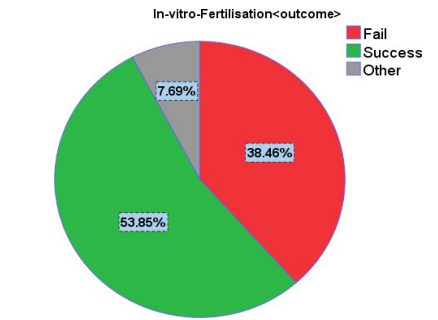
Figure 1: Showing IVF outcomes of the patient having endometriosis or adenomyosis.
Endometriosis cysts (endometriomas), Adenomyosis and stages of disease:
In our sample, 76.02% of the women had endometriosis cysts (endometriomas) and13.7% of women had Adenomyosis.
A total of 193 women were evaluated for the severity of Endometriosis. It was found that 39.4% of women had reached the high stage of the disease "third stage" (Figure 2).
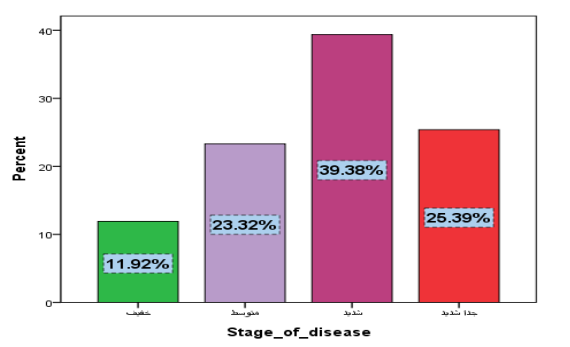
Figure 2: Stage of the disease of all patients in percentages.
Table 1: Showing IVF outcome variations according to Adenomyosis, Endometriosis cysts and the severity of Endometriosis.
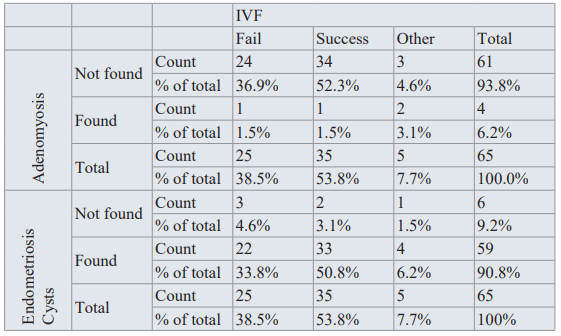
The highest success rate of IVF was in women who were in stage 2 of endometriosis (29.2%) and IVF failure rate was mainly in women who were in stage 3 of endometriosis (20%) (Figure 3).
While Women with Endometriosis cysts had higher success rates of IVF than failure; 50.8% compared with 33.8%.
IVF success rate was higher than failure in women with adenomyosis 52.83% compared with 36.9% (Table 1).
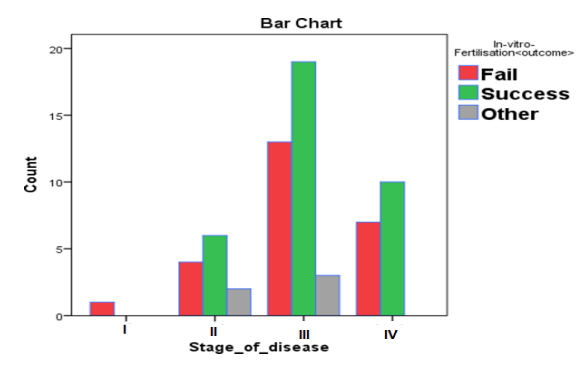
Figure 3: Stage of Disease and IVF outcome.
Endometriosis cysts and stage of disease variations according to adenomyosis:
The percentage of women without adenomyosis was higher from those who have it, whether they had endometriosis cysts or not.
The highest percentage of women with endometriosis cysts corresponds to the highest rate of being free of adenomyosis (Table 1 and 2).
Table 2: Endometriosis cysts and stage of disease variations according to adenomyosis.
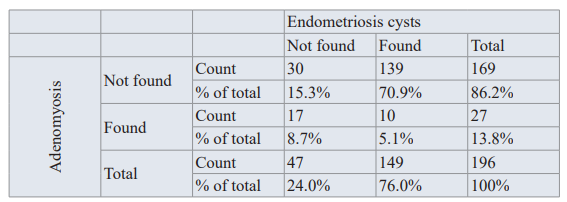
The percentage of women with adenomyosis is lower in all endometriosis stages compared with the percentage of women without adenomyosis.
Most women with adenomyosis had reached the second stage of endometriosis (5.7%). The women without adenomyosis mostly reached the third stage of endometriosis (37.3%) (Figure 3).
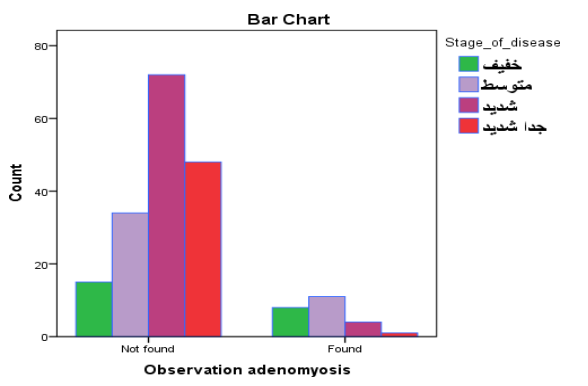
Figure 4: Adenomyosis and endometriosis stages of disease.
There is no statistically significant difference in the mean of IVF attempts between the severity stages of endometriosis P>0.05.
There is a statistical correlation between adenomyosis and worse IVF outcomes P<0.05.
There is no correlation between the endometriosis severity and IVF outcome P>0.05.
There is no correlation between endometriosis severity, adenomyosis and number of IVF attempts P>0.05. There is a statistical correlation between endometriosis severity and adenomyosis P<0.05 (Figure 4).
Discussion
Endometriosis is one of the most important causes of infertility. The mechanism of endometriosis-related infertility, or its impact on IVF, has not been fully established [10].
Advanced endometriosis means worse prognosis for IVF treatment compared to milder stages or tubal factor infertility [12].
Results of studies evaluating the effects of adenomyosis on the outcome of in vitro fertilization (IVF) treatment have been mixed (20–30). A previous meta-analysis of nine studies concluded that adenomyosis might have a negative impact on IVF treatment outcomes, as it decreases the rates of implantation and clinical pregnancy and increases the miscarriage rate [11].
According to our results there was no correlation between the presence of adenomyosis and the IVF number of attempts but it was correlated with worse IVF outcomes.
Endometriosis is often found in women with adenomyosis, which might be an additional cause for infertility [11]. In our study, higher stages of endometriosis were statistically correlated with higher incidence of adenomyosis.
Conclusion
The ASRM classification of endometriosis is useful in predicting IVF outcome [12]. The highest success rate of IVF was in women who were in mild of endometriosis and IVF failure rate was increased mainly in women who were in severe endometriosis. So the presence of Adenomyosis affects IVF outcome and decreases the rate of implantation.
References
- Fauconnier A, Chapron C. Endometriosis and pelvic pain: epidemiological evidence of the relationship and Hum Reprod Update. 2005; 11: 595-606.
- Hirsch M, James MN Duffy, Jennie O Kusznir, et Variation in outcome reporting in endometriosis trials: A systematic review. Am J Obstet Gynecol. 2016; 214: 452-464.
- Giudice LC, Kao Endometriosis. Lancet. 2004; 364:1789-1799.
- Counsellor Endometriosis. A clinical and surgical review. Am J Obstet Gynecol. 1938; 36: 877.
- Olive DL, Schwartz Endometriosis. N Engl J Med. 1993; 328: 1759-1769.
- https://endometriosisnews.com/2017/07/13/stages-of-endometriosis/
- Graziano A, Monte GLo, Piva I, et al. Diagnostic findings in adenomyosis: a pictorial review on the major concerns. Eur Rev Med Pharmacol Sci. 2015; 19: 1146-1154.
- Pontis A, D'Alterio MN, Pirarba S, et al. Adenomyosis: a systematic review of medical Gynecol Endocrinol. 2016; 32: 696-700.
- Garavaglia E, Audrey S, Annalisa I, et al. Adenomyosis and its impact on women fertility. Iran J Reprod Med. 2015; 13: 327-336.
- Bulun Endometriosis. N Engl J Med. 2009; 360: 268-279.
- Younes G, Tulandi T. Effects of adenomyosis on in vitro fertilization treatment outcomes: a meta-analysis. Fertil 2017; 108: 483-490 e483.
- Pop-Trajkovic S, PopoviÄ? J, AntiÄ? V, et al. Stages of endometriosis: does it affect in vitro fertilization outcome. Taiwan J Obstet Gynecol. 2014; 53: 224-226.